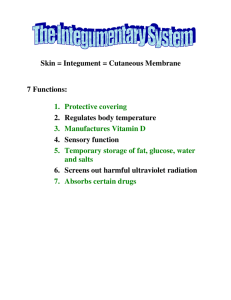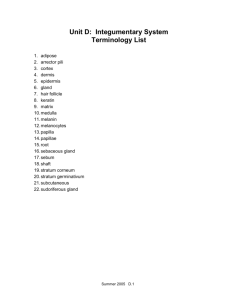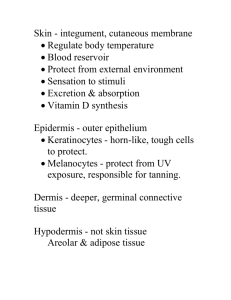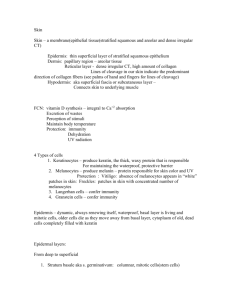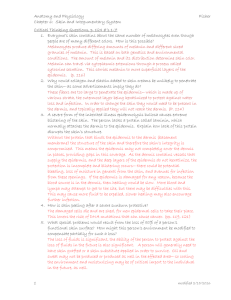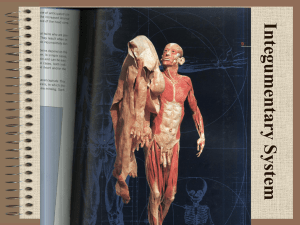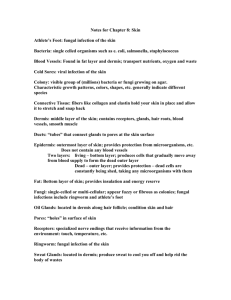Integumentary System
advertisement
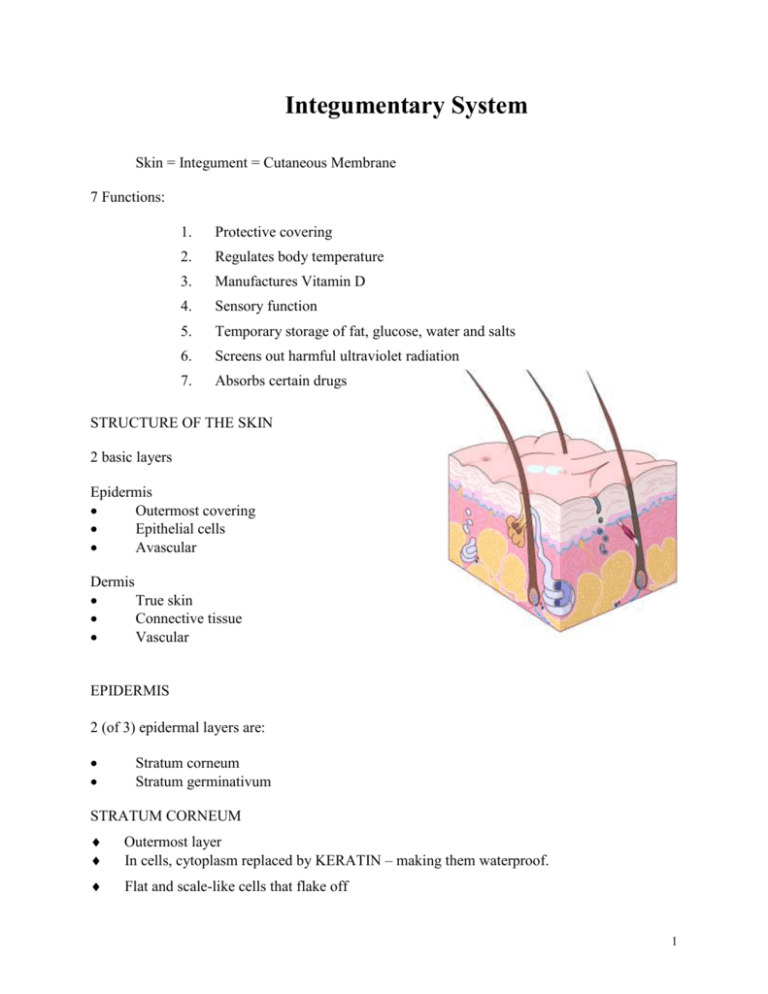
Integumentary System Skin = Integument = Cutaneous Membrane 7 Functions: 1. Protective covering 2. Regulates body temperature 3. Manufactures Vitamin D 4. Sensory function 5. Temporary storage of fat, glucose, water and salts 6. Screens out harmful ultraviolet radiation 7. Absorbs certain drugs STRUCTURE OF THE SKIN 2 basic layers Epidermis Outermost covering Epithelial cells Avascular Dermis True skin Connective tissue Vascular EPIDERMIS 2 (of 3) epidermal layers are: Stratum corneum Stratum germinativum STRATUM CORNEUM Outermost layer In cells, cytoplasm replaced by KERATIN – making them waterproof. Flat and scale-like cells that flake off 1 First line of defense against surface bacteria Thickest palms of hands, soles of feet STRATUM GERMINATIVUM Innermost epidermal layer Reproductive layer – cells form and push their way up, become keratinized, and replace the top layer Contains MELANOCYTES – cells that contain a pigment = MELANIN Melanin Black, brown, or has a yellow tint – depending on racial origin The more melanin, the darker the skin Caucasians don’t have much melanin in their melanocytes. Freckles = patches of melanin Albinism = no melanin Tanning Sunlight stimulates melanocytes to make more melanin Tanning produced by UV rays. Prolonged exposure may lead to skin cancer! PAPILLAE Ridges in stratum germinativum that arise from dermis Create permanent ridges in fingers, palms and soles of feet These “friction ridges” help with grip Cause “fingerprints” 2 DERMIS Thicker inner layer that contains: Connective tissue Blood vessels Nerve endings Muscles Hair follicles Oil and sweat glands Fat cells Nerve Receptors in Dermis Sensory nerves – heat, cold, touch, pain and pressure Touch receptors close to the surface Pressure receptors are deeper Subcutaneous Layer Lies under the dermis (not really part of integumentary system) Made up of loose connective tissue Contains half of the body’s stored fat Appendages of the Skin HAIR Almost everywhere on the body Length, thickness, type and color varies Outer layer = CORTEX Inner layer = MEDULLA Part under the skin = ROOT Part outside the skin = SHAFT FOLLICLE = pocket in epidermis, hair inside PAPILLA = tuft of tissue in root, contains capillaries ARRECTOR PILI MUSCLE = smooth muscle attached to follicle. How does this muscle cause goose bumps? 3 NAILS Nail is formed in the nail bed or MATRIX Epidermal cells fused together and fill with keratin SWEAT GLANDS Perspiration is 99% water SUDORIFEROUS GLANDS Distributed over the entire skin surface Large numbers under the arms, palms of hands, soles of feet and forehead Duct extends to form a pore in the skin, perspiration excreted through the pores May be activated by heat, pain, fever and nervousness Average fluid loss is 500 ml per day SEBACEOUS GLANDS Secret oil (SEBUM) that protects and lubricates the skin Skin and Microorganisms Intact skin = best protection against pathogens, toxins and water loss Skin generally too dry for microbial growth – they do grow in moist areas Most skin bacteria associated with hair follicles or sweat glands Underarm perspiration odor caused by bacteria and perspiration The best way to prevent the spread of disease is by hand washing. 4 Disorders of the Skin ACNE VULGARIS Common and chronic disorder of sebaceous glands Sebum plugs pores area fills with leukocytes Also – blackheads, cysts, pimples and scarring ATHLETE’S FOOT Contagious fungal infection Usually contracted in public baths and showers Rx – antifungal agents DERMATITIS Non-specific inflammation of skin Can be rash – reaction to soap, plants, etc. Can be emotional – stress can cause skin blotches ECZEMA Acute or chronic, inflammatory skin disease Dry, red, itchy and scaly Rx – remove or avoid causative agent, hydrocortisone to help alleviate the symptoms WARTS (VERRUCAE) Caused by virus Some disappear spontaneously, others removed with liquid nitrogen, chemicals or laser IMPETIGO Acute, inflammatory and contagious Seen in babies and young children Caused by staphylococcus or streptococcus Characterized by the appearance of vesicles which rupture and develop distinct yellow crusts PSORIASIS Chronic inflammatory skin disease Characterized by dry reddish patches which are covered with silvery-white scales Affects the skin surface over elbows, knees, shins, scalp and lower back 5 Cause – unknown Onsets triggered by stress, trauma or infection RINGWORM Highly contagious fungal infection Raised, itchy circular patches with crusts Skin, scalp or underneath nails Rx – griseofulvin (drug) URTICARIA or HIVES Itchy wheals or welts Usually an allergic reaction to drugs, food, etc. Rx – avoid allergen BOILS (CARBUNCLES) Painful, bacterial infection of hair follicle or sebaceous glands Caused by staphylococcus organism Rx – antibiotics, excision and drainage of affected area SHINGLES (HERPES ZOSTER) Viral infection of nerve endings Chest or abdomen, accompanied by severe pain Rx – medication for pain and itching HERPES SIMPLEX I Viral Fever blister or cold sore GENITAL HERPES Viral Blister in genital area Spread through sexual contact Periods of remission and exacerbation Rx – Acyclovir Can be passed to newborn during vaginal delivery SCABIES Communicable, severe itching 6 Mite burrows in skin, lays eggs, eggs hatch SKIN CANCER Associated with exposure to sun (UV rays) Most common type of cancer in people BASAL CELL CARCINOMA Most common, least malignant skin cancer Usually occurs on face Rx – surgical removal or radiation SQUAMOUS CELL CARCINOMA Mostly scalp and lower lip Grows rapidly and metastasizes to lymph nodes Rx – surgical removal or radiation Prognosis good with early diagnosis MALIGNANT MELANOMA Occurs in melanocytes Metastasizes to other areas quickly Appears as brown or black irregular patch that occurs suddenly A change in an existing wart or mole may indicate melanoma Rx – surgical removal of melanoma and surrounding area and chemotherapy BURNS Caused by radiation, sun, boiling water, chemicals, fire or electricity RULE OF NINES – Measures percent of body burned. Body divided into 11 area, each is 9% of body surface. FIRST DEGREE Superficial Skin red and dry Involves only epidermis Rx – cold water Healing within one week SECOND DEGREE Epidermis and dermis Pain, swelling, redness and blistering 7 Skin may be exposed to infection Rx – pain medication, dry sterile dressing Healing within 2 weeks THIRD DEGREE Epidermis, dermis and subcutaneous layers Symptoms – loss of skin, blackened skin (ESCHAR) May be life threatening Rx – prevention of infection and contracture, fluid replacement, skin graft SKIN LESIONS BULLA – large blister MACULE – freckle, petechia NODULE - wart PAPULE – elevated nevus PUSTULE - acne ULCER – venous stasis ulcer (superficial or decubitus) TUMOR – benign epidermal tumor, basal cell carcinoma VESICLE – chickenpox, herpes simplex WHEAL – hives, insect bites Terms ALBINISM – absence of melanin ALOPECIA – baldness EXCORIATION - abrasion PRURITIS – itching URTICARIA - hives 8
